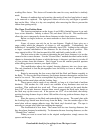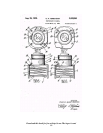Download this book for free at http://www.TheArgusA.com/
62
slight modification, however, the Argus can produce all sorts of “artistic flaws”. It also
allows a surprising degree of control over the intentional flaws.
This modification places a “mask” about 1/8
th
of an inch above the focal plane,
between the negative and the lens. Therefore, light traveling through the lens must pass
through the mask before it reaches the negative. If the mask is flat and clear the image
should remain the same, but if the mask is imperfect in any way it will distort the image.
So what kind of imperfections can a plastic mask have in order to make the
photograph more interesting? It can be scratched, melted, burned, cut, colored, written
on, crinkled, etc. It can be stained with water, oil, ink, grape juice, etc. It can be a hard
plastic like acetate, a soft plastic like cellophane, or something in between like the
wrapper of a Twinkie. It can be flat or bent or wrinkled. The imperfections can be across
the whole mask, along the edges of the mask, or just in the middle. If using black and
white film, the mask can be colored to simulate the effects of a filter. The mask doesn’t
even have to be plastic; any transparent or translucent material will work just as well.
For example, tissue paper dampened by a few drops of oil produces a dreamy effect,
similar to an impressionist painting.
The deformation of the mask is a part of the creative process. Scratching the
mask with fine steel wool in an even, random pattern will make the picture blurry. If the
scratches are just in a few similar directions, the picture will smear in just one direction.
Coarsely grained sand paper can be used to produce visible parallel lines.
The mask is placed inside the camera 1/8
th
of an inch above the negative. When
the Body is separated from the Neck and Shutter assembly, the mask can be placed inside
of the Body cavity precisely on top of the focal plane. Only 1/8
th
inch of the bakelite
Body will separate the negative from the mask. The spring in the Neck will keep the
mask flat once the Neck is replaced.
First, a masking material must be found. Art supply stores sell acetate sheets that
work particularly well, especially when protected from scratches by sheets of tissue
paper. They are also commonly available in yellow, red, green, blue, and grey.
Transparency sheets for overhead projectors are also a good source of masking material,
so long as they are not scratched up. Scientific supply stores sell thin sheets of polarized
plastic that add a polarizing effect.
Now the masking material must be cut into the shape of the Body cavity. The
easiest way to do this is to use the Body itself to outline the shape. Remove the Neck and
Shutter assembly from the Body by undoing the four retaining screws. Lay the Body,
with the front of the camera down, onto the masking material and trace the inside of the
Body cavity onto the material. Use scissors to cut out the resulting circle, taking care not
to touch or damage the round mask.
Place the mask into the body cavity. Ambient dust from the camera body and the
light-proof tape will land on the mask and must be cleaned off. Dampening the light-
proof tape with a few drops of water helps to minimize the dust that comes off of it.
Once the filter is at the bottom of the cavity, replace the Neck and Shutter assembly.
While loading the film into the camera, be careful not to get dust onto the film
side of the filter. Try not to rotate the Neck and Shutter because the Neck spring may
rotate and damage the mask.
Unfortunately, there is no easy method to determine the “filter factor” for a newly
installed mask. Run a roll of test film under various lighting conditions to determine the


















